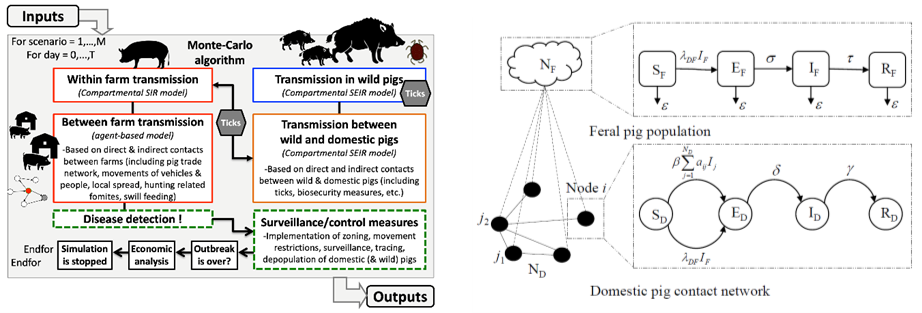Issue:
The lack of accessible, operational, tools that allow the rapid estimation and update of the risk of ASF introduction and spread under diverse and continuously changing epidemiological scenarios, makes it difficult to identify the pathways, areas, and time periods at higher risk of disease introduction/spread (and its associated uncertainty) in a timely manner. Thus, it becomes an important barrier to better plan and allocate ASF preventive, early detection, and control/risk-mitigation strategies in the US.
Objectives:
- Develop a quantitative risk assessment to evaluate the risk of ASF introduction into the US through multiple pathways; imported feed components, contaminated fomites, unintentional introduction in passenger cargo, international garbage and its inappropriate use for swill feeding, importation of contaminated pork and pork products, etc.
- Develop a spatially explicit disease spread model to evaluate the progression of ASF once introduced.
- Develop an open access online dashboard to facilitate adoption and quick update of risk assessment and US ASF disease spread model. Models will use open-source data and will provide risk estimates for the entire US and at fine spatio-temporal scale by state.

Value Proposition:
The web-based dashboard with the dynamic risk assessment and modeling tools will provide an operational tool for DHS and other US officials at the federal and state level to dynamically assess the risk of ASF introduction/exposure/spread per pathway. This will help identify the most important introduction/exposure/spread pathways and pathways with high uncertainty (due to potential data gaps) where additional data collection is needed.
| Project Lead | University of California, Davis |
| Research Team | PI: Beatriz Martinez Lopez, DVM, MPVM, Ph.D., University of California, Davis Co-PI: Caterina Scoglio, Ph.D., Kansas State University Co-PI: Maria Jose Clavijo, DVM, Ph.D., Iowa State University Co-PI: Gustavo Silva, DVM, MS, Ph.D., Iowa State University |
| Budget | $500,000 |
| Duration | July 2022 – June 2024 |
